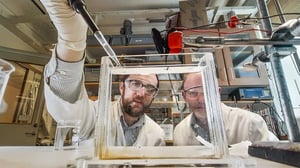Bioengineers from the Swedish university of Linköping have managed to produce artificial muscle tissue that, like “real” tissue, uses oxygen and glucose (the “main” sugar in our metabolism) to extract the necessary energy to contract the fibers and create movement. The results of the study appeared in the scientific journal Advanced Materials.
But how was it possible to achieve this major result that, if confirmed by other research, will free artificial muscles (and the robots or the objects that contain them) from the need to be connected to batteries? Up to now all the artificial muscles created had been made of three layers: two external membranes with electrical charges with the opposite sign that, when duly stimulated, generated a current, and an internal layer, which transformed the current into movement, because it either contracted or expanded depending on how the electrical charges were produced or “expelled”.
Until now, as we said, however, the reaction had always been triggered by a “separate” source, such as, for example, a battery, with all the practical problems that this entails (weight, frequently excessive bulkiness and the need to recharge the device). The Swedish researchers found a way to overcome this obstacle, by introducing two enzymes into the artificial muscle – glucose-oxidase and laccase – which (together with other molecules) metabolize glucose in the human body in the presence of oxygen, thus providing the body with all the energy it needs. In addition to these two substances, the researchers also used a special material (a polymer called polypyrrole) to make the electrical “conductibility” of the internal layer of the muscle particularly efficient.
“To make our device contract, all you have to do is immerse it in a glucose solution”, explained Edwin Jager, professor in the Department of physics, chemistry and biology of Linköping University, “Just as in biological muscles, the glucose is directly converted to motion in the artificial muscles. But in the future, it will also be possible to use different enzymes to produce energy starting with other substances: in practice, with substances that artificial muscles will find in their natural surroundings”.
When this new type of artificial muscle is developed further (we are currently at the stage of the first prototypes), it will find many practical applications in robotics and micro-robotics, and in implantable medical devices. The researchers also suggest that it could be useful for monitoring devices operating autonomously in aqueous environments.
Photo credits: Thor Balkhed

